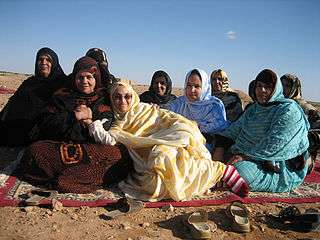Women in the Sahrawi Arab Democratic Republic

Women in the Sahrawi Arab Democratic Republic are women who were born in, who live in, or are from the Sahrawi Arab Democratic Republic (SADR) in the region of the Western Sahara. In Sahrawi society, the women share responsibilities at every level of its community and social organization.[1] Article 41 of the Constitution of the Sahrawi Arab Democratic Republic ensures that the state will pursue "the promotion of women and [their] political, social and cultural participation, in the construction of society and the country's development".
Clothing
Clothing worn by the Sahrawis include the robe called as the Daraa. Women wear the headscarf known as the mefhla.[2][3]
Role in refugee camps
The Polisario Front, a national liberation movement that is recognized by the United Nations as the representative of the people of Western Sahara since 1979, has attempted to modernize the society of the Sahrawi refugee camps that was set up in Tindouf Province, Algeria from 1975 to 1976, through emphasis on education, eradication of tribalism and emancipation of women. The role of Sahrawi women was central already in pre-colonial and colonial life, but was strengthened further during the war years (1975–1991), when Sahrawi women ran most of the camps' administration, while the men were fighting at the front.[4] This together with literacy- and professional education classes produced major advances in the role of women in Sahrawi society. The return of large numbers of Sahrawi men since the cease fire in 1991 may have slowed this development according to some observers, but women still run a majority of the camps' administration,[5] and the Sahrawi women's union UNMS is very active in promoting their role. The role of women in camps was enhanced by their shouldering of the main responsibility for the camps and government bureaucracy during the war years, as virtually the entire male population was enrolled in the Polisario army.[6]
Politics
In the 2012 election for seats in the Sahrawi National Council, 35% of the parliamentarians were women. In the legislative election in 2008 women gained 34.61% of seats, thanks in part to a quota system.[7]
See also
- National Union of Sahrawi Women (NUSW)
- Polisario Front
- Sahrawi refugee camps
- Women in Western Sahara
References
- ↑ Donati, Simone. Saharawi, Terra Project Photographers.
- ↑ National Geographic Magazine, december 2008
- ↑ Mentioning of Daraa robe
- ↑ Gina Crivello; Elena Fiddian; Dawn Chatty (December 2005). "Background to the Western Sahara Conflict". FMO, Refugee Studies Centre, University of Oxford.
- ↑ "Country Operations Plan: Algeria. Planning year: 2007" (PDF). UNHCR. 2006.
- ↑ Andrew Borowiec (2003). Taming the Sahara: Tunisia Shows a Way While Others Falter. Praeger/Greenwood. p. 32. ISBN 0-275-97647-5.
- ↑ "Renewal of the Saharawi Parliament reached 61,53%". Sahara Press Service. 2008-02-25. Retrieved 2008-04-21.
External links
| Wikimedia Commons has media related to People of Western Sahara. |
| Wikimedia Commons has media related to Sahrawi Refugee camps in Tindouf Province. |
- Some 120 Saharawi women benefit from an 'online' training project sponsored by the University of Valencia, University of Valencia.
- Belloso, María López and Irantzu Mendia Azkue. Local Human Development in contexts of permanent crisis: Women’s experiences in the Western Sahara, HEGOA Institute of Development and International Cooperation Studies (Bilbao), University of the Basque Country.
